Did you know that some fish can actually change their gender? It’s true! There are over 500 species of fish that have the ability to switch from male to female or vice versa. This process, called sequential hermaphroditism, is an amazing adaptation to help these animals survive in different environments and make sure their species continues.
In this blog post, we’ll take a closer look at some of the fascinating fish that can change genders and explore how they do it. Read on to learn more about these remarkable creatures.
20+ Fish That Change Gender
Before we break it down in detail, here is a chart about all the fish regarding one of their most interesting behavior.
| Fish Name | Interesting Behavior |
| Ambon damselfish | They are known to be very territorial and aggressive |
| Asian sheepshead wrasse | They have the ability to change color and pattern |
| Australian barramundi | They can produce vocal sounds to communicate with each other |
| Bicolor parrotfish | They sleep in a cocoon of self-produced mucus |
| Black sea bass | They have the ability to change their sex |
| Blackhead seabream | They can change their color to blend in with their habitat |
| Bluebanded goby | They form symbiotic relationships with pistol shrimp |
| Bluehead wrasse | They swim using their pectoral fins |
| Bluestreak cleaner wrasse | They provide cleaning services for other fish |
| California sheephead | They have strong jaws to crush their prey |
| Chinook salmon | They are born in freshwater but migrate to the ocean |
| Clark’s anemonefish | They form symbiotic relationships with sea anemones |
| Clownfish | They are born male |
| Harlequin tuskfish | They have powerful jaws to crush their prey |
| Lyretail anthias | They form large schools in the wild |
| Pacific cleaner shrimp | They provide cleaning services for other fish |
| Peppermint shrimp | They have a symbiotic relationship with anemones |
| Potter’s angelfish | They have a unique pattern on their body similar to pottery |
| Red grouper | They have a unique courtship behavior |
| Ribbon eel | They have the ability to change color and pattern |
| Saddleback wrasse | They have a unique color pattern on their body |
| Spotted knifejaw | They are known for their unique swimming style |
Ambon damselfish

The Ambon damselfish (Pomacentrus amboinensis), also known as the blue devil damselfish, is a small but fascinating fish species commonly found in the coral reefs of the Indo-Pacific region.
Its diet consists of small invertebrates such as crustaceans, mollusks, plankton, algae, and other vegetation found in its marine environment. These fish have a high metabolism and require a lot of food to maintain their energy levels and stay healthy.
Ambon damselfish can be found in shallow waters with plenty of coral reefs and rocky outcroppings. They prefer to live in areas with lots of hiding places and crevices where they can take cover and avoid predators. These fish are also known for their territorial behavior, often defending their chosen area from other nearby fish.
Perhaps the most interesting aspect of the Ambon damselfish is its ability to change sex. Like many other fish species, these fish are born with both male and female reproductive organs. However, as they mature, they will typically switch to one sex or the other.
In some cases, if there are not enough females in the area, a male fish may even switch to becoming a female in order to maximize its chances of reproduction. This trait is known as sequential hermaphroditism and is a unique adaptation that helps these fish to survive and thrive in their marine environment.
Asian sheepshead wrasse
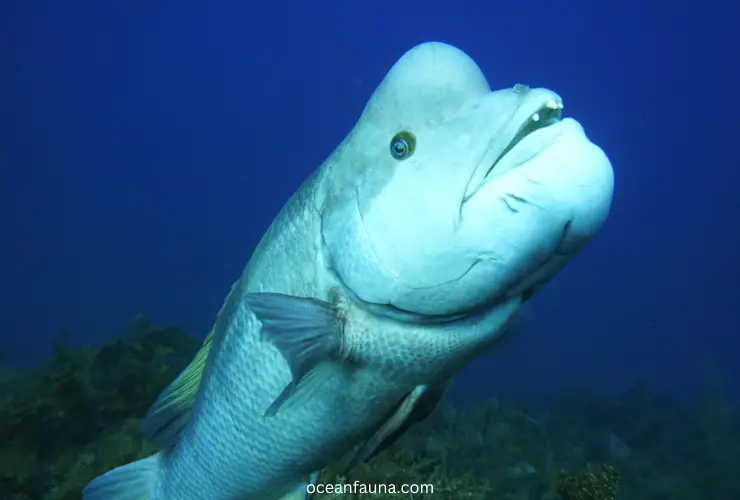
The Asian sheepshead wrasse (Semicossyphus reticulatus) is a species of fish found in the Pacific Ocean from Japan all the way to Australia.
Asian sheepshead wrasse mainly feeds on crabs, mollusks,, other crustaceans, as small fish, and occasionally algae.
Like many other fish species, Asian sheepshead wrasse can change genders. These fish can switch from being males to females as they mature, or vice versa, depending on the circumstances and needs of their population. This behavior is called sequential hermaphroditism and is believed to be a way for the fish to maximize their chances of successful reproductive behavior.
Australian barramundi
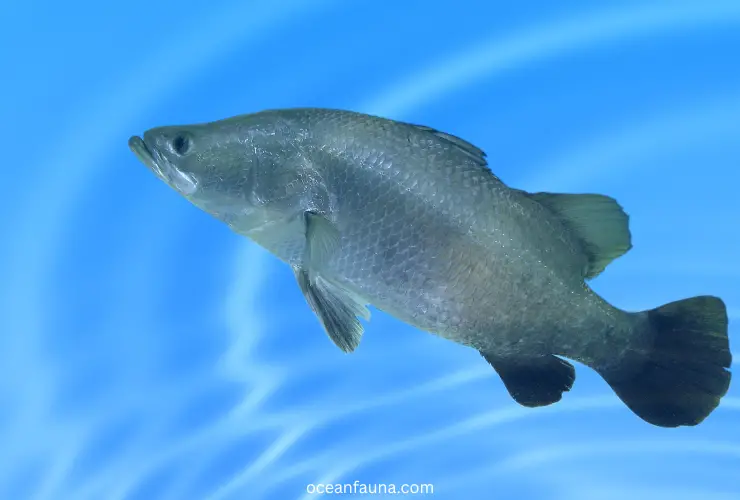
The barramundi (Lates calcarifer) is a type of fish that lives in rivers and along the coast of Australia, specifically from Exmouth Gulf to the Northern Territory border.
These fish are known for their hardy nature and wide diet, which includes crustaceans, mollusks, small fish, and insects.
Barramundi can change their sex from male to female or vice versa, depending on the conditions of their population. This is called sequential hermaphroditism and is an adaptation that allows the species to thrive in different environmental conditions.
Bicolor parrotfish
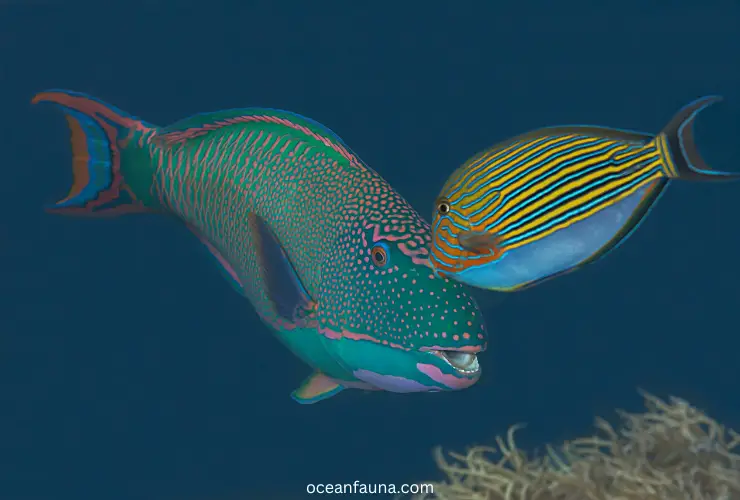
The bicolor parrotfish (Cetoscarus bicolor) is a species of fish found throughout the tropical waters of the Indo-Pacific region.
These fish have an omnivorous diet that includes coral, algae, and other small invertebrates such as mollusks and crustaceans.
Bicolor parrotfish are also known for their ability to change sex. These fish are typically born with both female and male reproductive organs but then switch to one or the other regarding maturity. They mostly gain maturity at the age of five years.
Black sea bass
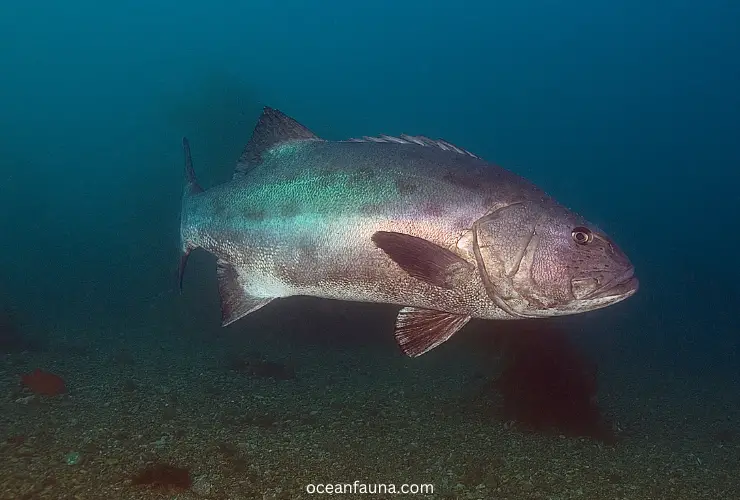
Black sea bass (Centropristis strata) is a type of fish that can be found along the eastern coast of North America from Maine to Florida and in the Gulf of Mexico. These fish are also known for their unique habit of changing sex as they mature, with females transitioning to males as they grow older.
When it comes to diet, black sea bass are opportunistic feeders that will consume a variety of prey, including small fish, crustaceans, and squid. They can be found in a variety of habitats, from rocky reefs to soft-bottomed areas, and can tolerate a wide range of water temperatures and salinity levels.
Black sea bass is also known for their slow growth and longevity, with some individuals living up to 20 years or more. They are an important commercial and recreational fish species, with management efforts focused on maintaining sustainable populations through size and bag limits and seasonal closures during their spawning season.
Blackhead seabream
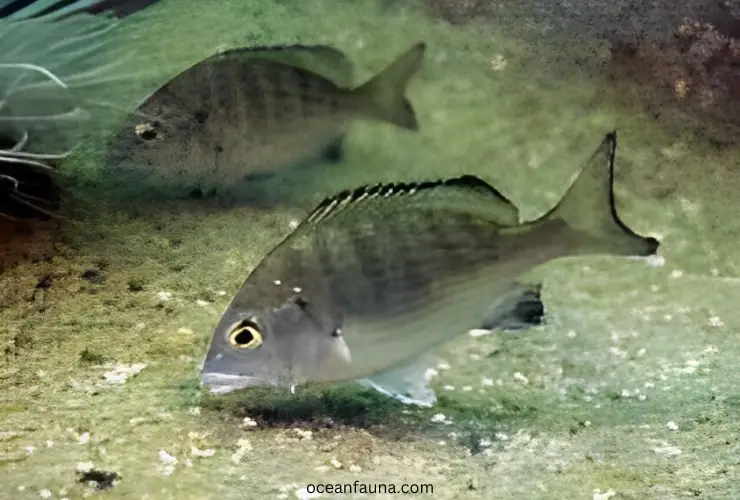
The Blackhead seabream, which is found from southern Hokkaido, Japan, to the southern Korean Peninsula, as well as the middle and north coast of the Republic of China and Taiwan, has a silver-grey body with a distinct black band on its head. Its scientific name is Acanthopagrus schlegelii.
Blackhead seabreams have a diverse diet. They feed on small fish, crustaceans, mollusks, and plankton. They are also known to eat seaweed in some instances. Their diet can vary according to their habitat and availability of food.
Blackhead seabreams have an exciting trait where they are born as females but turn into males as they age, known as protogynous hermaphroditism. The transition usually occurs when they are around three years old and 20cm long. The sex change is triggered by environmental factors such as temperature changes.
Bluebanded goby
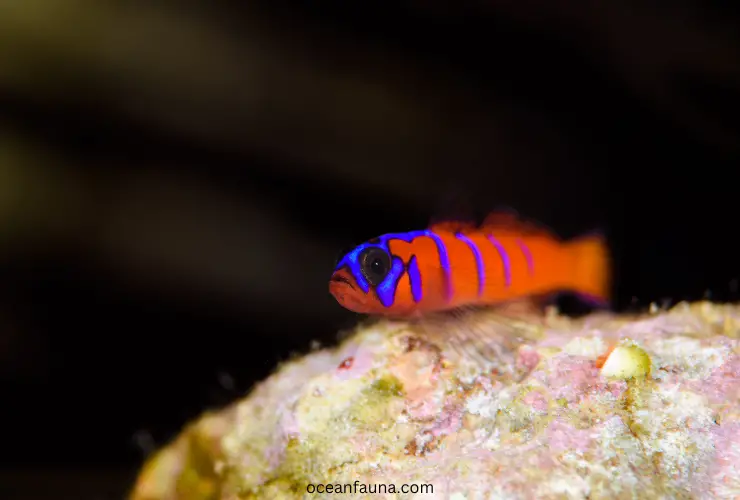
The bluebanded goby (Lythrypnus dalli) is a species of fish found in shallow waters and coral reefs of the eastern Pacific Ocean. This small, colorful fish has a light tan body with vivid blue stripes that distinguish it from other similar species.
Bluebanded gobies have an omnivorous diet, consuming a variety of algae and invertebrates such as small crustaceans and mollusks. They have also been known to feed on the mucous secretions of fish, an adaptation that allows them to survive in low-oxygen environments.
Bluebanded gobies can change their sex from male to female or vice versa, which is called protogynous hermaphroditism. This behavior helps them to adapt to the male-female ratio within their population and increase their chances of reproducing successfully.
Bluehead wrasse
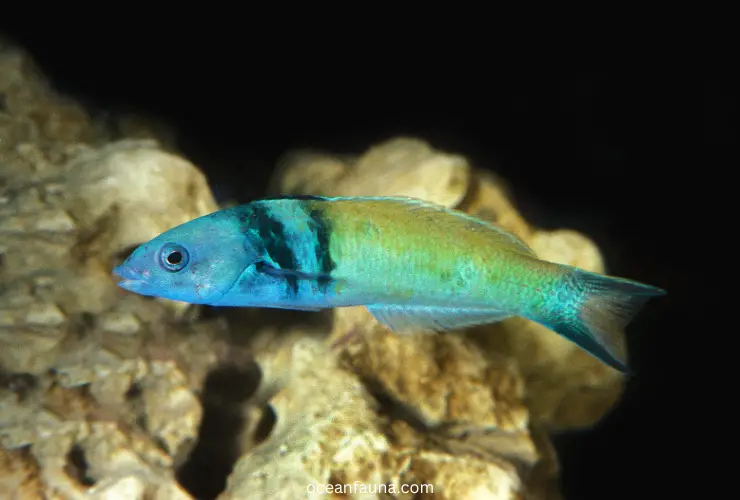
The bluehead wrasse (Thalassoma bifasciatum) is a species of colorful marine fish found in reefs throughout the Caribbean, Gulf of Mexico, and Florida. These fish are generally light green to blue-grey in color, with two distinct black stripes running horizontally across their bodies.
Bluehead wrasses are typically found in small groups around coral reefs, where they feed on various crustaceans and mollusks. They are also known to pick up pieces of dead coral and other debris from the sea floor, an adaptation that helps them forage for food more efficiently.
Like many other fish species, bluehead wrasses can undergo sex changes. The fish start out as females, and if the dominant male in a group dies or is removed, one of the remaining females will transition to become the new dominant male. This process is known as sequential hermaphroditism.
Bluestreak cleaner wrasse
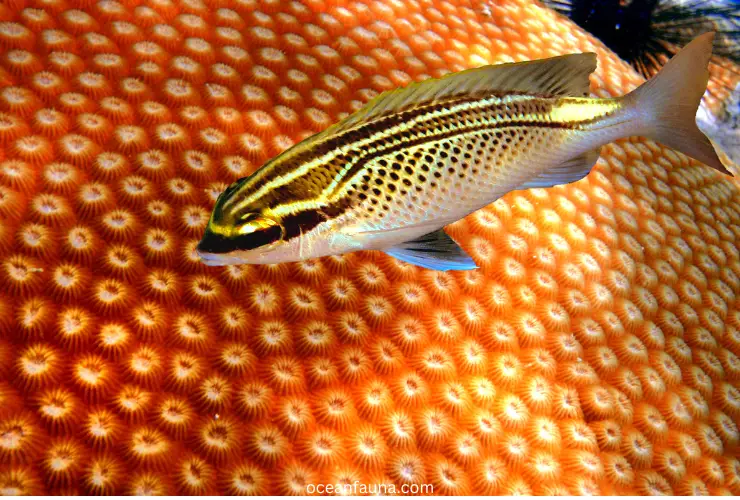
The Bluestreak cleaner wrasse (Labroides dimidiatus) is a small, brightly-colored fish found in coral reefs throughout the Indian and Pacific Oceans. These fish are distinguished by their red bodies with blue stripes running down their sides.
Bluestreak cleaner wrasses have an interesting behavior that makes them an essential part of the marine ecosystem. These fish clean other larger fish by consuming parasites and dead skin, a process known as “cleaning.” This behavior not only improves the health of the larger fish but also provides food for the wrasse.
Bluestreak cleaner wrasses are sequential hermaphrodites, which means they start out as females but can change sex to become males if there is a shortage of dominant males in the group. This allows them to adapt to environmental changes and increases their chances of successful reproduction.
California sheepshead
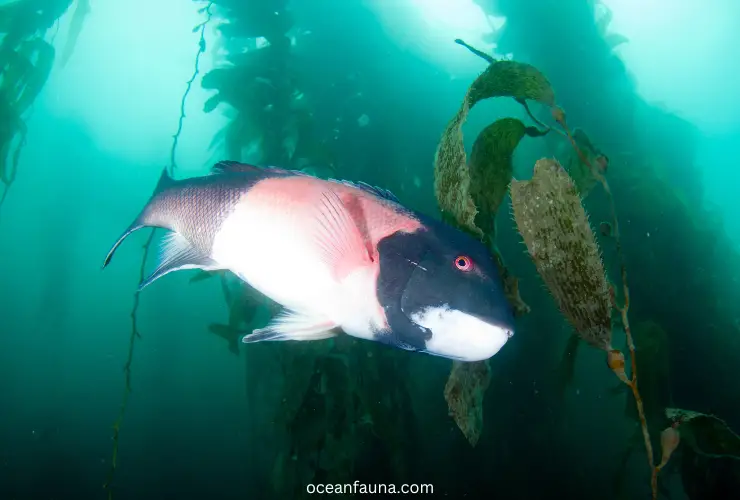
The California sheepshead (Semicossyphus pulcher) is a species of fish found along the coast of the Pacific Ocean from Baja, California, to Alaska. These fish have a unique appearance, with their thick, box-like heads and reddish-brown bodies covered in white stripes.
The California sheepshead has an omnivorous diet. They primarily eat hard-shelled invertebrates like sea urchins and mollusks. They use head muscles to crack open their prey. Additionally, they consume algae and other vegetation when there is a chance.
California sheepshead has a unique ability to change its gender. They all start their life as females but can turn into males when there are not enough dominant males in the population.
Chinook salmon
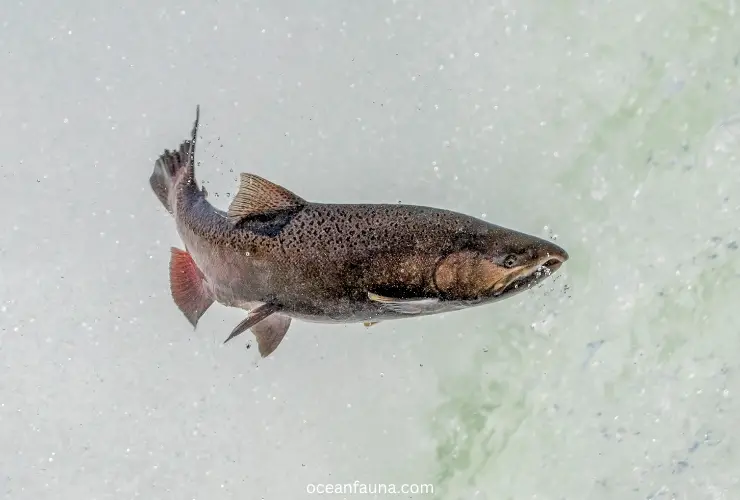
The Chinook salmon (Oncorhynchus tshawytscha) is an anadromous fish found in rivers and streams along the Pacific Coast. These fish are generally silver-green in color with black spots on their backs and tails, though some can have bright red or orange stripes.
Chinook salmon spend most of their lives in the ocean but migrate to freshwater streams and rivers to spawn. During the spawning season, they feed on small crustaceans, insects, and other aquatic organisms. After they spawn, they die within a few days or weeks.
Chinook salmon have an exciting life cycle—they start as eggs and then turn into fry, living organisms that can swim freely. They eventually reach maturity, then migrate back to the ocean to feed and grow before returning to their spawning grounds.
Clark’s anemonefish
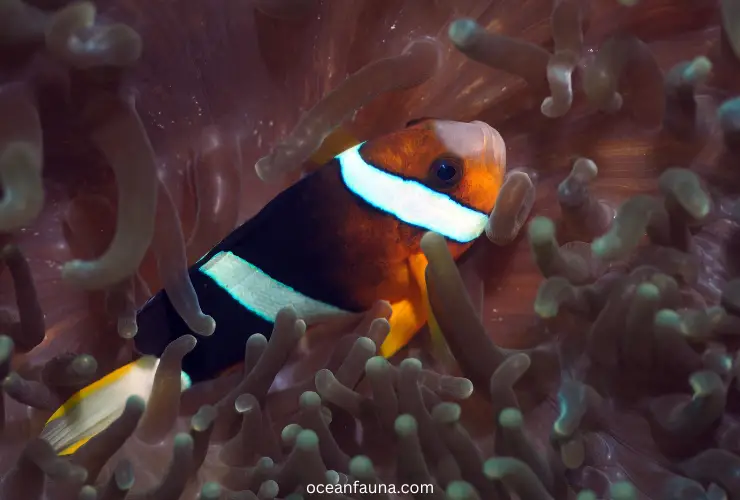
Clark’s anemonefish (Amphiprion clarkii) are coral reef-dwelling fish that are found in the Indo-Pacific region. They have bright orange bodies with three white stripes running along their sides, giving them a striking appearance.
These fish form symbiotic relationships with sea anemones, which protect them from predators. In return, the anemonefish cleans and maintain the tentacles of the anemone, ensuring it remains healthy and safe.
Clark’s anemonefish is a type of fish that is born female but can become male if there aren’t enough dominant males around. This helps them better survive and mate in their community.
Clownfish
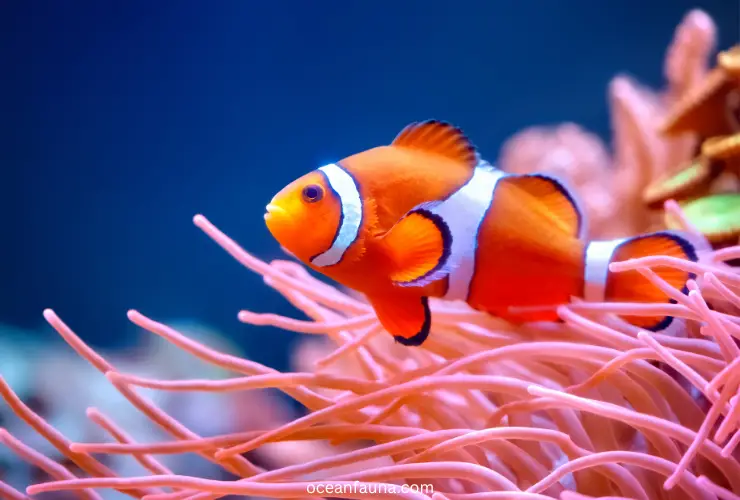
Clownfish (Amphiprion ocellaris) is small, brightly-colored fish found in coral reefs throughout the Indian and Pacific Oceans. They have an orange body with three white stripes running along their sides, giving them a unique look.
Clownfish form symbiotic relationships with sea anemones, which protect them from predators. In return, the anemonefish cleans and maintain the tentacles of the anemone, ensuring it remains healthy and safe.
Clownfish are a type of fish that are born male but can become female if there aren’t enough dominant females around. This helps them better survive and mate in their community. They have a life expectancy of up to 10 years in the wild.
Harlequin tuskfish
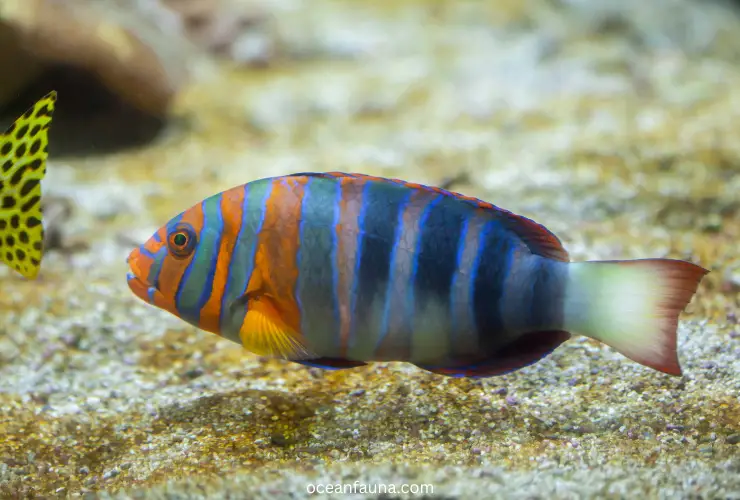
The Harlequin tuskfish (Choerodon fasciatus) is a fish species that inhabit coral reefs in the Western Pacific region. This fish has a bright blue body with orange marks on its sides, making it easily recognizable.
Harlequin tuskfish are omnivorous and feed mainly on hard-shelled invertebrates like crabs, mollusks, and sea urchins. They use their large teeth to crush open the shells of their prey.
These fish are solitary by nature and can live up to 10 years in the wild. They are also protogynous hermaphrodites, meaning they start out as females and can transition to become male if the population lacks dominant males. This adaptation increases their chances of successful reproduction in the wild.
Lyretail anthias
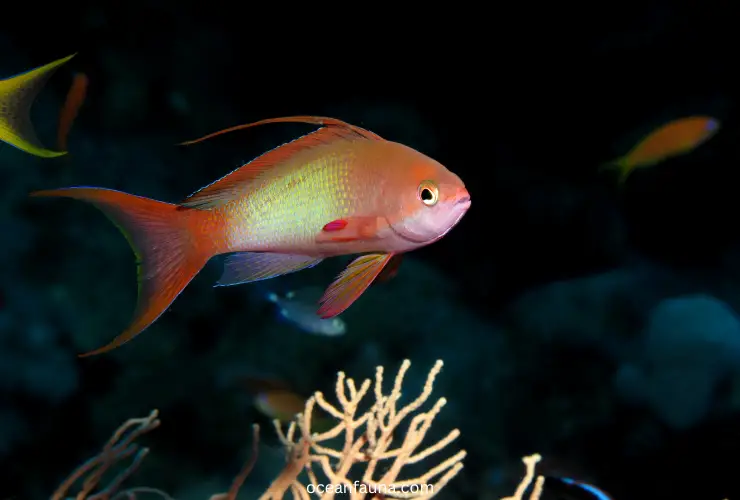
The lyretail anthias (Pseudanthias squamipinnis) is a type of colorful small fish that can be seen in coral reefs across the Indo-Pacific area. Its body is orange, complemented by white and yellow stripes on its sides, making it easily recognizable.
Lyretail anthias form large schools that swim close to the water’s surface, searching for plankton and other small organisms as food. The males are typically larger and more brightly colored than the females, so they stand out from the rest of the school.
These fish have a lifespan of up to 5-6 years in the wild, though some can live longer in captivity. They are protogynous hermaphrodites, meaning they start out as females and can transition to become male if the population lacks dominant males.
Pacific cleaner shrimp
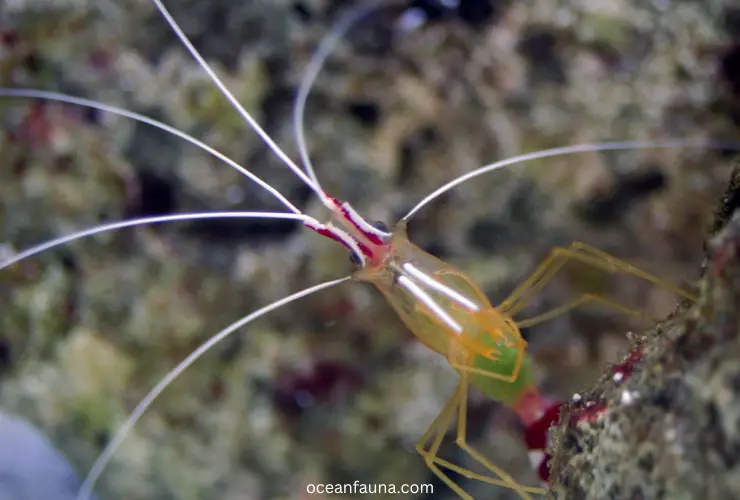
The Pacific cleaner shrimp, also called Lysmata amboinensis, is a type of small shrimp found in the Indo-Pacific region. It has a striking appearance with its bright blue stripes that extend along the sides of its orange body, which sets it apart from other species.
These shrimp perform a vital service to other fish by cleaning parasites and dead skin off of their bodies. In return, the fish provide them with protection from predators.
In the wild, Pacific cleaner shrimp usually live for 3-5 years but can have a longer lifespan in captivity. These shrimp are protandrous hermaphrodites, which means they begin their lives as males but can change to females if there are not enough females in their group.
Peppermint shrimp
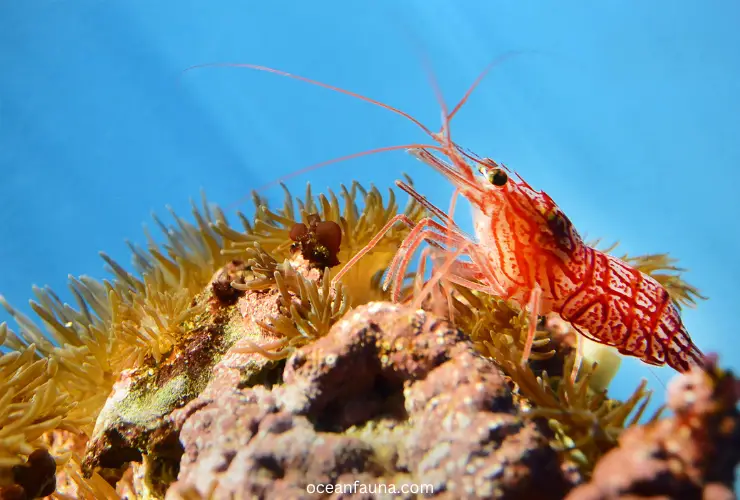
The peppermint shrimp (Lysmata wurdemanni) is a type of shrimp that is small and has bright colors. It can be found in the Florida Keys, Key West, and the Gulf of Mexico, especially in shallow reef habitats.
These shrimp feed on small amphipods and other scavenger organisms found in their coral reef habitat. They also benefit other fish by cleaning parasites and dead skin off of their bodies.
Peppermint shrimp can live for about 2 years in the wild. In captivity, they may live even longer. These shrimp are protandrous hermaphrodites, meaning they begin as males but can become females if no dominant females are present in their community.
Potter’s angelfish
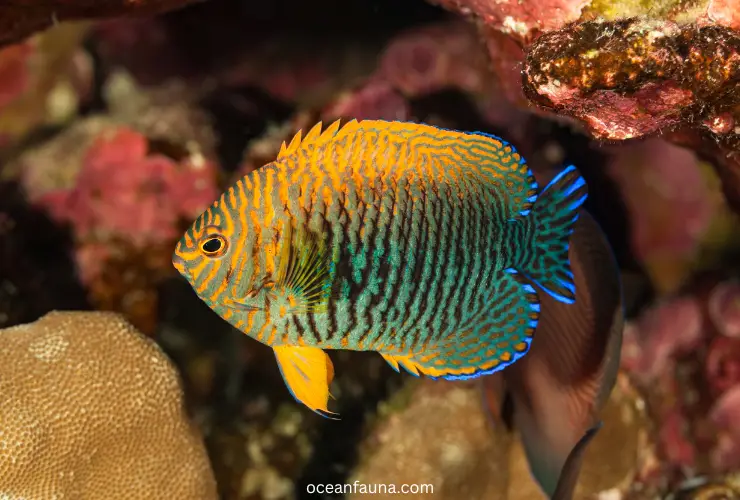
The Potter’s angelfish, also known as Centropyge potteri, is a type of vividly colored fish inhabiting coral reefs across the Pacific. It has an orange body with blue patterns, making it a visually stunning creature.
Potter’s angelfish feed mainly on sponges and do not form schools with other fish. They are solitary by nature and like to swim around in search of food or rest near the bottom of their habitat.
The fish have a lifespan of approximately 6 years in the wild, but they can survive longer if kept in captivity. They are protogynous hermaphrodites, meaning they mature first as females but can later transform into males when dominant males are absent. This characteristic enhances their breeding success in their natural environment.
Red grouper
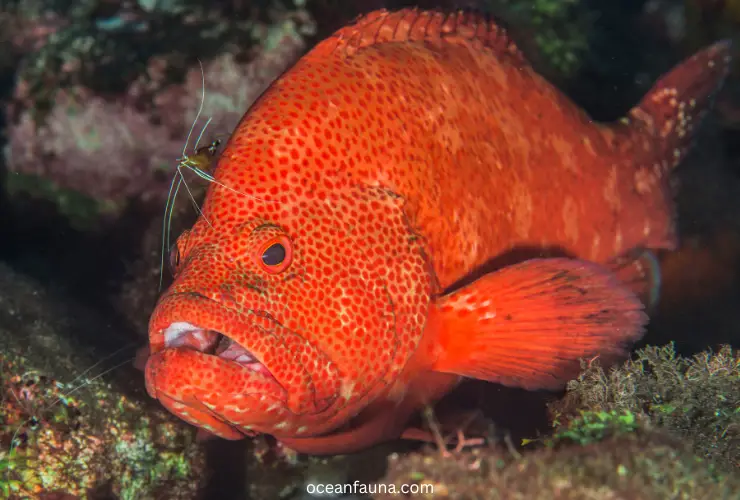
The red grouper (Epinephelus morio) is a species of large saltwater fish that can be found in the Atlantic, Caribbean, and southern Gulf of Mexico. It has an olive green-tinted body with reddish spots or stripes, which gives it its name.
These fish typically live on reefs and feed on fish, crustaceans, and mollusks. In some areas of their range, they have been found to form large schools that can become a major food source for other predators in the area.
Red groupers have a lifespan of up to 30 years in the wild. However, in captivity, some have been known to live longer. These fish are protogynous hermaphrodites, meaning they begin their lives as females and can become males if there are no dominant males in their population.
Ribbon eel
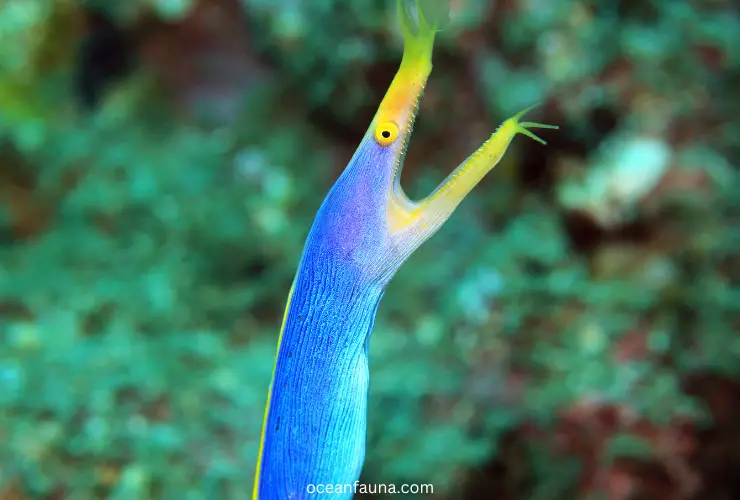
The ribbon eel, also known as Rhinomuraena quaesita, is a species of eel found in the Indian and Pacific Oceans. It has an elongated body and comes in many colors ranging from yellow to blue.
It is the habit of these eels to feed on small invertebrates, and they prefer to conceal themselves in caves and crevices of coral. They tend to be solitary and spend most of their time swimming in search of food or hiding from predators.
Ribbon eels have a lifespan of up to 20 years in their natural habitat. However, if kept in captivity, they can live even longer. These eels are protandrous hermaphrodites, meaning they begin as males but may later become females as they age.
Saddleback wrasse
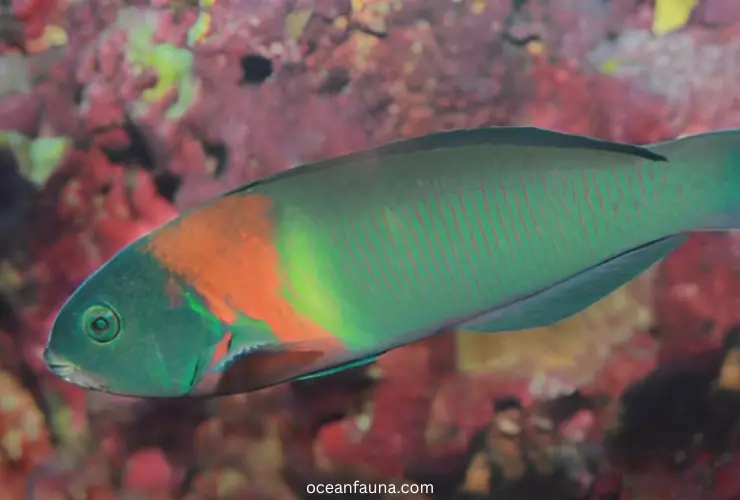
The saddleback wrasse, or Thalassoma duperrey, is a fish in the Indian and Pacific Oceans. It has a vibrant yellow and purple body with two black stripes running along its sides.
These wrasses feed mainly on mollusks and small crustaceans in their coral reef habitat. Saddleback wrasses typically form schools with other fish, and they migrate throughout the day in search of food or for mating purposes.
The lifespan of the saddleback wrasse in the wild varies between 8-10 years. In captivity, however, some have been known to live even longer. These fish are protogynous hermaphrodites, meaning they begin as females and can later become males if dominant males are absent.
Spotted knifejaw

The spotted knifejaw (Oplegnathus punctatus) is a type of fish found in the Pacific Ocean. It has an oval-shaped body with bright yellow and black spots, which gives it its name.
Spotted knifejaws are voracious feeders and typically feed on small crustaceans, mollusks, and occasionally other fish. They usually swim near the bottom of their habitat for food or rest near the reef.
Spotted knifejaws are protogynous hermaphrodites, meaning they mature first as females but can later become males when dominant males are absent. This helps them increase their breeding success in the wild.
Conclusion
This article is about the only 22 fish that change gender under conditions like captivity and when counter gender is absent. From the red grouper to the spotted knifejaw, we have discussed the characteristics of each species and their ability to transform from female to male when necessary.
If you have more queries about this fish, let us know.


3 thoughts on “20+ Fish That Change Gender [Amazing Facts]”